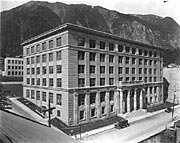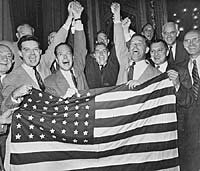Governing Alaska
A New Era in Alaska
In the United States Capitol building in Washington, D.C., every state is allowed to display statues of two outstanding citizens. The National Statuary Hall collection includes presidents, vice presidents, signers of the Declaration of Independence, framers of the United States Constitution and other distinguished Americans.
The two Alaskans cast in bronze are Sen. E.L. "Bob" Bartlett and Sen. Ernest Gruening. Before they served as Alaska's first United States Senators, Bartlett and Gruening were the powerful one-two punch of the Alaska statehood fight in the 1940s and 1950s.
Historian Claus Naske has written that while Bartlett and Gruening did not invent the statehood movement, they "gave it a vitality and dynamism which it had not possessed before."
Although Gruening and Bartlett shared a commitment to statehood and membership in the Democratic party, their personalities couldn't have been more different. Bartlett served as Alaska's non-voting delegate to Congress for 14 years before statehood and Gruening worked as territorial governor from 1939-53.
A. Robert Smith, a newspaper reporter who wrote about Congress for 25 years said, that Bartlett was "Mr. Nice Guy in a body overpopulated with SOBs." Gruening was a brilliant politician and writer who had a knack of making his opponents, and sometimes even his friends uncomfortable.
As the non-voting Alaska delegate, Bartlett had no votes to trade, so he concentrated on winning friends and influencing people. A former miner and Fairbanks newspaperman, Bartlett earned the respect of Alaskans, who knew him as "Bob," a name he picked up as a child when his 4-year-old sister refused to call him by his real name "Edward." Bartlett represented Alaska in Washington, D.C. for the last 25 years of his life, first as a delegate and then for nine years as a senator. Elected seven times as delegate from 1944-59, he devoted his energies to persuading members of Congress that Alaskans deserved better than the "second-class citizenship" of territorial rule.
Bartlett became a convert to the statehood campaign after former Delegate Anthony Dimond advised that it was the only practical way to proceed, because Congress would probably fight any effort to seek piecemeal improvements in the First Organic Act.

Alaska Capitol, Juneau, ca. 1931
Bird's-eye view of the Federal and Territorial Building in Juneau, from the south.
After completing 13 years as governor, Gruening wrote a book titled "The State of Alaska," which was published five years before statehood. He used the book as a way to publicize what he thought of as federal neglect of the territory. Gruening's awareness of Alaska's situation really started when President Franklin D. Roosevelt appointed him as governor in 1939, two days after Hitler attacked Poland and began World War II.
In Alaska, Gruening soon found himself at odds with the canned salmon industry, the shipping industry and the mining industry over new taxes. He wanted them. They didn't.
Describing revenues to the territory from Alaska's resources as "virtually negligible," he spent the next ten years fighting for change. "The wealth of Alaska was being drained off and next to nothing was staying there for its needs," he wrote later.
Gruening complained that the old tax system benefited special interests and harmed the average Alaskan. He said the dividends from the huge Kennecott mine, which had been abandoned in 1938 after producing $200 million in copper, had enriched "many individuals who never saw Alaska and had no thought of ever coming here or doing anything for the Territory. . ."
Although mining and fishing topped the list of industries, by 1947 more money poured into the treasury from alcohol than anything else. "At that time we had no financial structure that was worthy of the name," Mildred Hermann, a Juneau attorney, recalled. "We financed our government on the basis of how the red salmon ran and how much liquor people drank and that was almost the total source of our revenues. . .."
Starting in 1941, Gruening introduced measures for a modern tax system. The legislature though refused to act. The low point came in 1947, when lawmakers created a fiscal crisis, authorizing more than $10 million in spending and only $6.3 million in income. The money ran out that fall. In the crisis that followed, the University of Alaska kept going only because members of the Board of Regents, UA President Charles Bunnell and business leaders offered emergency loans to keep the doors open.
Gruening wrote in his autobiography that Alaska voters responded by "throwing the rascals out" in the 1948 election. "Alaskans realized how an effectively organized minority in the legislature had betrayed their interests and had left the territory in a deplorable state," he said.
With the change in Juneau, a comprehensive new tax system won approval in 1949, an act that some viewed as a prerequisite to show that Alaska was ready for statehood.
For Bartlett and Gruening, another decade would pass before they achieved their common goal.
Links:
Biographies of E.L. "Bob" Bartlett
- Biographical Directory of the United States Congress
Biographies of Ernest Gruening
- Biographical Directory of the United States Congress
Information about Statuary Hall
- National Statuary Hall
Selling Statehood
In his 1946 State of the Union address President Harry S. Truman said that statehood should be granted as soon as the government knew where the people of Alaska stood on the issue. He had an answer soon enough.
In an advisory vote that fall, Alaskans voted 9,630 to 6,822 in favor of joining the union. George Sundborg, a journalist who had made a pro-statehood study, said the size of the negative vote was due to the "sourpuss branch of the sourdough family."
Many Alaskans looked for more support from the Truman administration and Congress after the vote, but resistance remained. Bartlett introduced one of many statehood bills in 1947. In one hearing, the head of Alaska Airlines testified about pressure by the salmon industry to keep quiet, or else he would lose their business.
The debate in 1947 framed the arguments that would continue for more than a decade. Supporters said statehood was a matter of justice for Americans who lived in Alaska and were denied their rights, and were ruled by an absentee government and absentee industries. Opponents said Alaska could not afford statehood and should remain a territory until economic conditions changed. The pro-statehood forces responded that conditions would never change until Alaska gained control over its own destiny, which could only happen with admission to the union.In 1949, the legislature approved creation of the Alaska Statehood Committee, an 11-member group headed by Anchorage Times Publisher Bob Atwood. The Committee pushed the statehood effort through education and lobbying. The campaign failed to make much national headway for three years though, because of the Korean War.
Following the war, Sen. Hugh Butler of Nebraska, a statehood opponent, announced that his committee would hold hearings in Alaska. He said he didn't want to hear from "just a few aspiring politicians who want to be senators and representatives, but from the "little people" of Alaska.
A group of supporters that formed with the name "Little Men For Statehood" turned out in support of statehood at Butler's 1953 hearings. Signs popped up in Anchorage store windows that said, "I'm a Little Man Who Wants Statehood." Women agreed. Margaret Rutledge of Anchorage told a story of how she had been on her way to the inauguration of President Dwight D. Eisenhower when she was reminded of the second-class status of Alaskans. At the Seattle airport she had to go through immigration procedures, which she said was humiliating. Before ending her testimony in tears, Rutledge told the senators that a "degrading influence had robbed me of the thing I value most--my birthright as an American."
The statehood movement developed strong support in the mid and late 1950s among average Alaskans, who signed onto grassroots organizations such as "Operation Statehood" and the "John Q. Citizen" campaign.
National politics entered into the picture because Republicans feared that Alaska would send Democrats to Congress, which could tip the scales of power. The Republican Eisenhower administration supported statehood for Hawaii, which was expected to be favorable to the GOP, but delayed on admitting Alaska.
Links:
- Speech by President Truman in which he gave tentative support to statehood.
- President Truman's 1948 message to Congress about Alaska.
- 1950 letter by President Truman to Sen. Mahoney about statehood
- A brief history of Alaska statehood
- Public Papers of the Presidents
- President Eisenhower's comments in 1955 about why he wanted to delay statehood.
- President Eisenhower's misgivings about statehood in 1956
The Canned Salmon Lobbyist
Because he had once been a commissioner, people often referred to him as "Judge" Arnold. Because of his work for the canned salmon industry, his opponents dubbed him "Fish" Arnold. To his friends he was "Bill."
By any name, Winton C. Arnold was perhaps the most influential lobbyist in Alaska in the 1940s and 1950s. Arnold represented the canned salmon industry in Juneau during those years, and was a strong voice at Congressional hearings and in Juneau.
John Butrovich, a long time territorial and state senator from Fairbanks, once told a reporter that Arnold was exceptionally capable. "You couldn't be that good and not be smart," Butrovich said. "He was the best I saw, in my time, and I was there for 30 years. And I'm looking at it from the other side."
Butrovich opposed Arnold's work to continue the advantages of the canned salmon industry - including big tax breaks - in Alaska. Many said Arnold stopped andy tax reform legislation for a decade in the territorial Legislature. He became the most effective and articulate opponent of Alaska statehood.
Arnold typically did not say he opposed statehood. . He made a habit, though of pointing out obstacles, such as transportation problems, and the need to settle Alaska Native land claims. He also said Alaska could not afford to become a state because of the additional burdens that it would place on its citizens.
Since less than 1% of Alaska had been surveyed, it would take thousands of years for Alaska to acquire its land if a traditional land grant system was used with the granting of statehood, he said at one hearing.
Alaska territorial delegate E.L. "Bob" Bartlett described Arnold as an opponent of every progressive proposal for Alaska and "a smooth operator--intelligent and with a pleasing personality." He hosted private lunches for senators, and made elaborate presentations to show the economic damage that statehood would cause Alaska.
Mary Lee Council, Bartlett's administrative assistant, said that by explaining the problems with statehood bills before Congress in an attempt to stop statehood, Arnold's complaints forced Congress to resolve those issues. In that way, Arnold's stalling tactics improved the chances that the state would have the resources it needed for survival. The provisions eventually adopted by Congress gave the new state more than five times as much land as had been proposed in some of the early proposals.
Links:
- Women in Alaska's History - Elizabeth Peratrovch
